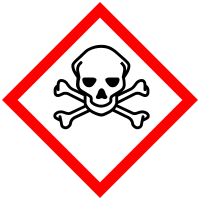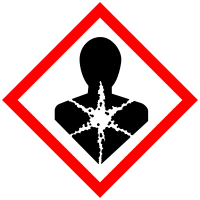
Improving Member States preparedness to face an HNS pollution of the Marine System (HNS-MS)
Chloroform
Description Top
| CAS number | 67-66-3 |
| UN number | 1888 |
| Chemical formula | CHCl3 |
| Accident occurred | Yes |
| Standard European Behaviour Classification (SEBC) | Sinker that dissolves (SD) |
| Notable risks | Reacts violently with strong bases, strong oxidants and some metals such as aluminium, magnesium and zinc. |
GESAMP Hazard profile
| A1 | A2 | B1 | B2 | C1 | C2 | C3 | D1 | D2 | D3 | E1 | E2 | E3 |
| 1 | NR | 2 | 0 | 2 | 0 | 2 | 1 | 1 | CT | NI | SD | 3 |
Marine pollution Classification (MARPOL Annex II)
| Category | Description |
| Y | Noxious Liquid Substances which, if discharged into the sea from tank cleaning or deballasting operations, are deemed to present a hazard to either marine resources or human health or cause harm to amenities or other legitimate uses of the sea and therefore justify a limitation on the quality and quantity of the discharge into the marine environment. |
Alternate names for this chemical
Formyl Trichloride
Methane Trichloride
Methenyl Trichloride
Methyl Trichloride
Trichloroform
Trichloromethane
Chloroform
Chloroforme
Methane Trichloride
Methenyl Trichloride
Methyl Trichloride
Trichloroform
Trichloromethane
Chloroform
Chloroforme
Physico-chemical properties Top
| Chemical formula | CHCl3 | ||
| Molar mass | 111.38 [g/mol] | ||
| Critical molar volume | 0.000239 [m³/mol] | ||
| State | Liquid at 25°C and 1 atm | ||
| Fusion temperature | -63.5 [°C] | ||
| Boiling temperature | 61.3 [°C] | ||
| Critical temperature | 536.4 [°C] | ||
| Density |
|
||
| Surface tension |
|
||
| Interfacial tension |
|
||
| Kinematic viscosity |
|
||
| Hydrosolubility |
|
||
| Vapour pressure |
|
||
| Critical pressure | 5470000 [Pa] | ||
| Vapour density | 4.5 | ||
| Vaporization enthalpy |
|
||
| Combustion enthalpy | 3180000 [J/Kg] | ||
| Specific heat capacity | 956.6 [J/(Kg·K)] | ||
| Combustion efficiency | 50 [%] | ||
| Mass flow rate of the combustion surface | 0.02 [Kg/(m²·s)] | ||
| Radiative fraction | 40 [%] | ||
| Henry's constant | 371 [mol/(m³·Pa)] |
Behaviour Top
| Log Kow | 1.97 |
| Log Koc | 1.5 |
| Hydrolysis (Half-life) | 450 days |
| Aqueous photolysis (Half-life) | 22 days |
| Biodegradation in estuary environment (Half-life) | Not biodegradable |
| Biodegradation in marine environment (Half-life) | Not biodegradable |
| Standard European Behaviour Classification (SEBC) | Sinker that dissolves (SD) |
| Bioconcentration factor (BCF) | 12.7 |
Ecotoxicity Top
| Lowest median lethal concentration (LC50) on algae | 13.3 [mg/l] | ||
| Lowest median lethal concentration (LC50) on crustacean | 29 [mg/l] | ||
| Lowest median lethal concentration (LC50) on fishes | 18 [mg/l] | ||
| Highest no observed effect concentration (NOEC) on algae | 3.61 [mg/l] | ||
| Highest no observed effect concentration (NOEC) on crustacean | 6.3 [mg/l] | ||
| Highest no observed effect concentration (NOEC) on fishes | 1.463 [mg/l] | ||
| Assessment factor (AF) |
|
||
| Predicted No Effect Concentration (PNEC) |
|
Hazards Top


Danger
| IDLH | 500 [ppm] |
Hazards statements
Health
H302
Harmful if swallowed.
H315
Causes skin irritation.
H319
Causes serious eye irritation.
H331
Toxic if inhaled.
H351
Suspected of causing cancer.
H361
Suspected of damaging fertility or the unborn child.
H372
Causes damage to organs through prolonged or repeated exposure, exposure cause the hazard:
Precautionary statements
Prevention
P202
Do not handle until all safety precautions have been read and understood.
P260
Do not breathe dust/fume/gas/mist/vapours/spray.
P280
Wear protective gloves/protective clothing/eye protection/face protection.
Response
P305 + P351 + P338
IF IN EYES: Rinse cautiously with water for several minutes. Remove contact lenses, if present and easy to do. Continue rinsing.
P308 + P313
IF exposed or concerned: Get medical advice/attention.
Storage
P403 + P233
Store in a well-ventilated place. Keep container tightly closed.
Disposal
P501
Dispose of contents/container to ...
GESAMP Top
GESAMP Hazard profile
| A1 | A2 | B1 | B2 | C1 | C2 | C3 | D1 | D2 | D3 | E1 | E2 | E3 |
| 1 | NR | 2 | 0 | 2 | 0 | 2 | 1 | 1 | CT | NI | SD | 3 |
A1: Bioaccumulation
| Rating | Description |
| 1 | Very low potential to bioaccumulate |
A1a:
| Rating | Description | Criteria [mg/l] |
| 1 | Very low potential to bioaccumulate | 1 ≤ Log Kow < 2 |
A1b:
| Rating | Description | Criteria |
| 1 | Very low potential to bioaccumulate | 1 ≤ BCF < 10 |
A2: Biodegradation
| Rating | Description |
| NR | Not readily biodegradable |
B1: Acute aquatic toxicity
| Rating | Description | Criteria [mg/l] |
| 2 | Slightly toxic | 10 < LC/EC/IC50 ≤ 100 |
B2: Chronic aquatic toxicity
| Rating | Description | Criteria [mg/l] |
| 0 | Negligible | NOEC > 1 |
C1: Acute oral toxicity
| Rating | Description | Criteria [mg/Kg] |
| 2 | Moderate | 50 < AOTE ≤ 300 |
C2: Acute dermal toxicity (skin contact)
| Rating | Description | Criteria [mg/Kg] |
| 0 | Negligible | ADTE > 2000 |
C3: Acute inhalation toxicity
| Rating | Description | Criteria [mg/l] (4 hours exposure) |
| 2 | Moderate | 2 < AITE ≤ 10 |
D1: Skin irritation or corrosion
| Rating | Description | Sign | GHS category |
| 1 | Mildly irritating | Mild erythema with or | Mild Irritant Category 3 |
D2: Eye irritation
| Rating | Description | Sign | GHS category |
| 1 | Mildly irritating | Mild conjunctival hype | Irritant Category 2B |
D3: Long-term health effects
| Notation | Hazard endpoint | Description | GHS category |
| C | Carcinogenicity | Chemicals which have been shown to induce or increase the incidence of cancer | Category 1 for Carcinogens |
| T | Specific Target, Organ Toxicity following single or repeated exposure | Significant changes which affect the morphology or biochemistry of tissues or organs; organ dysfunction up to death | Categories 1 and 2 for Specific Target Organ Toxicity Single (STOT-SE) or Repeated Exposure (STOT-RE) |
E1: Tainting of seafood
| Rating | Description |
| NI | No Information |
E2: Behaviour of chemicals in the marine environment
| Rating | Description |
| SD | Sinker that dissolves |
E3: Interference with the use of coastal amenities
| Rating | Interference | Description | Interpretation | Warning |
| 3 | Highly objectionable | 1 is highly acutely toxic; and/or 2 is severely irritant or corrosive to skin or eyes; and/or 3 is carcinogenic, mutagenic or reprotoxic; and/or 4 is a floater or persistent floater with associated health effects | 1 C1 and/or C2 and/or C3 = 4; and/or 2 D1 or D2 = 3, 3A, 3B, or 3C; and/or 3 D3 contains C, M or R; and/or 4 E2 = F or Fp and D3 contains Ss, Sr, T, A, N, or I | Warning issued leading to the closure of amenities |
GHS Security Information


Danger
About the project
HNS-MS is a decision-support tool that Belgian and French maritime authorities as well as coastguard stations can activate in order to forecast the drift, fate and behavior of acute marine pollution by Harmful Noxious Substances (HNS) accidentally released in the marine system.
Contact us
Copyright © 2015–2026 HNS-MS Consortium
 HNS-MS has been funded by DG-ECHO under agreement ECHO/SUB/2014/693705 and runs from 1 January 2015 to 31 March 2017.
HNS-MS has been funded by DG-ECHO under agreement ECHO/SUB/2014/693705 and runs from 1 January 2015 to 31 March 2017.